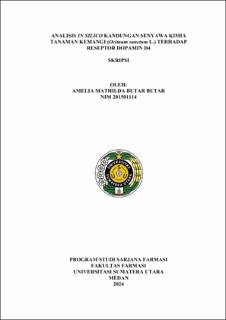| dc.description.abstract | Background: Schizophrenia is a mental disorder characterized by damage to the individual's thoughts, perceptions, emotions, movements and deviant behavior in which there is excessive release of dopamine. Antipsychotics, schizophrenia drugs that block dopamine receptors have side effects in the form of insomnia, increased body weight, can increase glucose and fat levels in the body, the emergence of extrapyramidal symptoms, hypotension, and an increase in the SGOT/SGPT enzyme, so new alternative drugs are needed that come from plants such as basil which can inhibit D4 receptors.
Objective: The purpose of this study is to determine the potential inhibition of DRD4 receptors using chemical compounds of basil plants in silico.
Methods: This study used SMILES and 3D structures of basil chemical compounds to predict biological activity using PASS Online, physicochemical properties using Lipinski's rule of five, docking validation, and molecular docking.
Result: The results showed that the docking validation results of DRD4 had an RMSD value of 0.392 Å. Isovitexin, Isoorientin, Rosmarinic Acid, Chryseriol, Cirsilineol, Cirsimaritin, Bieugenol, Spathulenol, Ferulic Acid, Terpinolene, Sinapinic Acid, Eugenol, Vanillic Acid, Carvacrol, Linalool, Methylisoeugenol, Protocatechuic Acid, Estragole, Vanillin, p-Hydroxybenzoic Acid, 1,2,4-Trimethylcyclohexane, Ethyl 13-methyltetradecanoate, Methyl 9-methyltetradecanoate, Citronellal, Ethyl Isovalerate, and 1,2-Cyclopentanedione compounds that meet the testing of biological activity, physicochemical properties, and docking analysis that have binding pockets that show the inhibitory side of DRD4.
Conclusion: The chemical compounds of basil plant can inhibit DRD4 receptors as a schizophrenia drug. | en_US |


